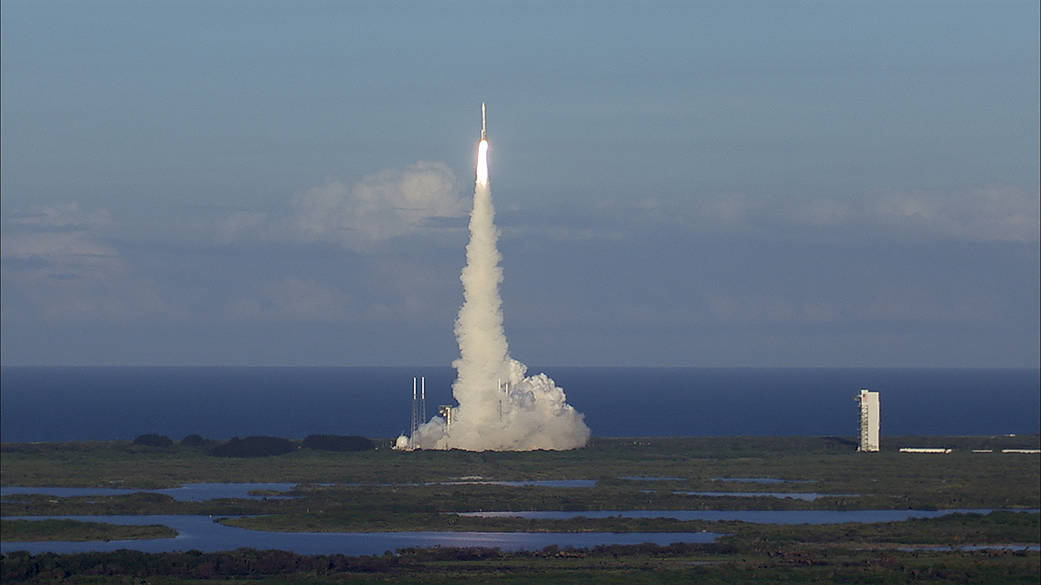An Atlas V rocket traced a blazing arc into the Florida sky Thursday evening to send a small robotic explorer on its way to an asteroid on a mission that scientists anticipate will reveal answers to some of the basic questions about the solar system.
“Tonight is a night for celebration, we are on the way to an asteroid,” said Ellen Stofan, NASA’s chief scientist. “We’re going to be answering some of the most fundamental questions that NASA works on.”

Lifting off at 7:05 p.m. from Space Launch Complex 41 at NASA’s Kennedy Space Center in Florida, the rocket’s launch was timed to put the OSIRIS-REx spacecraft, short for Origins, Spectral Interpretation, Resource Identification, Security-Regolith Explorer, on an exact course to reach the asteroid Bennu in August 2018.
Burning a combination of refined kerosene called RP-1 and liquid oxygen and carrying a single solid-fueled booster, the first stage of the United Launch Alliance Atlas V 411 pushed the spacecraft through the dense lower layers of the atmosphere, then the Centaur upper stage took over, propelling OSIRIS-REx faster and higher. About 55 minutes after launch, the asteroid sampling spacecraft separated from the liquid oxygen and liquid hydrogen fueled second stage rocket to fly free.
OSIRIS-REx will make a swing by Earth next year to gain a gravity assist that will accelerate it even faster to reach Bennu, where it will eventually go into orbit. Once orbiting the asteroid, OSIRIS-REx will spend two years surveying it in unprecedented detail.
Then, in a robotic first, the spacecraft will reach out its mechanical arm and take a sample from the asteroid. Though the sample will be small – only a couple of pounds at most – it will be a time capsule of sorts recording our solar system’s creation. With the sample stored safely, the spacecraft will speed away from the asteroid on a path back to Earth.
“This represents the hopes and dreams and blood, sweat and tears of thousands of people who have been working on this for years,” said Dante Lauretta, the principal investigator for OSIRIS-REx at the University of Arizona. “I can’t tell you how thrilled I was this evening, thinking of the people who played a part in this.”
Nearing Earth’s atmosphere seven years from now, a capsule containing the sample and equipped with a heat shield will detach from the main OSIRIS-REx spacecraft and enter Earth’s atmosphere. A parachute will slow the capsule down so it can be retrieved, then researchers will go about examining the precious cargo taken directly from an asteroid.
In earlier NASA missions, tiny samples of a comet and atoms collected from the solar wind have been taken and returned to Earth. Hundreds of pounds of rocks from the moon were returned to Earth by astronauts during six Apollo missions from 1969 to 1972. All these samples are curated by NASA’s Johnson Space Center in Houston, which also will house the majority of material that OSIRIS-REx collects; a few percent of the sample will be sent for curation by international partners, the Canadian and Japanese space agencies.
This flight is the third of NASA’s New Frontiers Program. The first two – New Horizons and Juno – have already made contributions to the study of the outer solar system and are still operating.
“We keep hitting it out of the park and tonight we hit it off the planet,” said Jim Green, director of NASA’s Planetary Science division.
NASA’s Launch Services Program, based at NASA’s Kennedy Space Center in Florida, managed the launch for the agency. NASA’s Goddard Space Flight Center in Greenbelt, Maryland will provide overall mission management, systems engineering and safety and mission assurance for OSIRIS-REx. Dante Lauretta is the mission’s principal investigator at the University of Arizona. Lockheed Martin Space Systems in Denver built the spacecraft. OSIRIS-REx is the third mission in NASA’s New Frontiers Program. NASA’s Marshall Space Flight Center in Huntsville, Alabama, manages New Frontiers for the agency’s Science Mission Directorate in Washington.






















